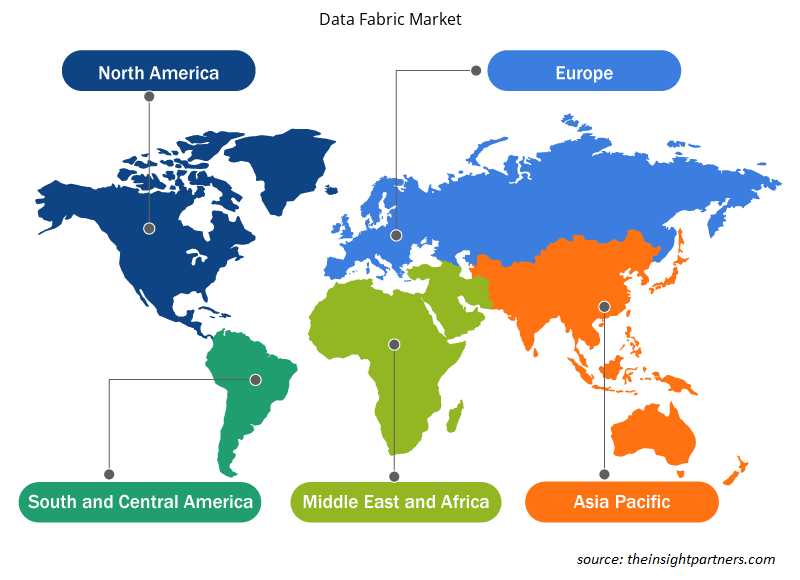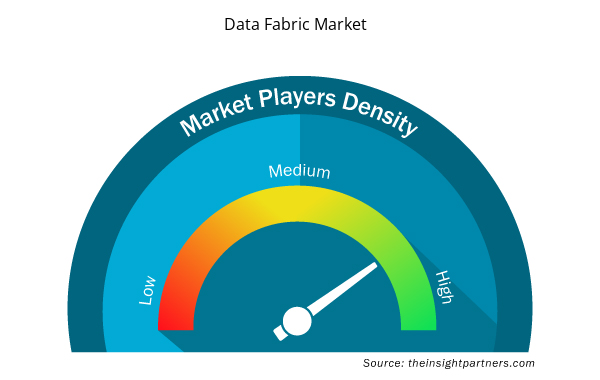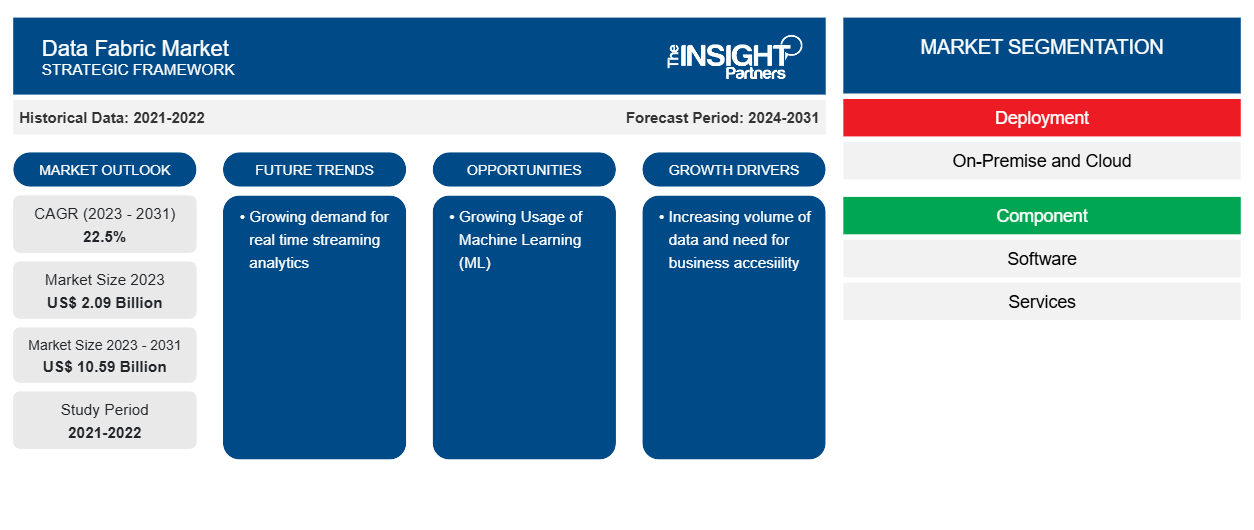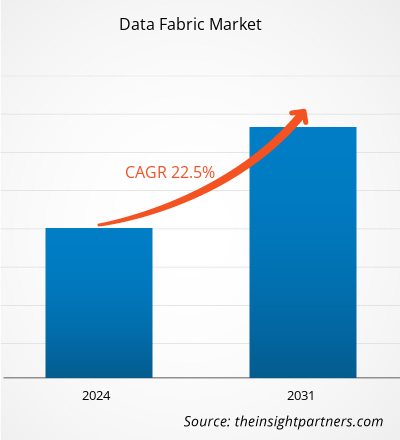データ ファブリック市場は、2023 年の 20 億 9,000 万米ドルから 2031 年には 105 億 9,000 万米ドルに成長すると予測されており、 2023 年から 2031 年にかけて 22.5% のCAGRで拡大すると予想されています。リアルタイム ストリーミング分析に対する需要の高まりが、市場の重要なトレンドになると予想されています。
データファブリック市場分析
データ ファブリックはデータ仮想化を提供し、企業はデータへのシームレスなアクセスを実装しながら、誰もがアクセスできるようにします。データ ファブリックを実装すると、ビジネス ユーザーは IT の関与を最小限に抑えてデータにアクセスできるため、データ アクセスとデータ交換のための環境がより高速かつ容易になります。適切に設計された論理データ ファブリックは、重要なセキュリティとデータ管理を一元化します。したがって、データ ファブリック市場は予測期間中に成長すると予想されます。
データファブリック市場業界概要
データ ファブリックは、アーキテクチャ、データ管理および統合ツール、共有データなどを含む包括的なデータ統合および管理システムであり、企業のデータ管理を支援します。データ ファブリックは、組織のグローバル ネットワークのすべてのメンバーに、単一の一貫したユーザー エクスペリエンスとリアルタイムのデータ アクセスを提供します。データ ファブリックは、さまざまなアプリケーション、プラットフォーム、場所にわたってデータを管理することで、企業が複雑なデータの問題やユース ケースを解決できるように支援することを目的としています。データ ファブリックは、分散データ環境でスムーズなアクセスとデータ共有を実現します。
要件に合わせてレポートをカスタマイズする
このレポートの一部、国レベルの分析、Excelデータパックなど、あらゆるレポートを無料でカスタマイズできます。また、スタートアップや大学向けのお得なオファーや割引もご利用いただけます。
- このレポートの主要な市場動向を入手してください。この無料サンプルには、市場動向から見積もりや予測に至るまでのデータ分析が含まれます。
データファブリック市場の推進要因と機会
データ量の増加が市場の成長を後押し
データ中心の組織では、時間、空間、さまざまなソフトウェアの種類、データの場所に対応する包括的なアプローチが必要です。データは、ファイアウォールの背後に隠されたり、複数の場所に分散されたりするのではなく、必要な人が利用できる必要があります。企業は、運用効率を向上させるために、安全で効率的で一貫性があり、将来を見据えたデータ ソリューションを必要としています。したがって、予測期間中にデータ ファブリックの需要が増加すると予想されます。
機械学習(ML)の利用拡大
MLアルゴリズムは、データパイプラインを監視し、関連するリンクと統合を提案する場合があります。これらのアルゴリズムは、データ構造にリンクされているデータから情報を抽出し、すべてのビジネスデータを確認して、関連するリンクと相関関係を見つけます。データの提供は、MLモデルのトレーニングで最も時間のかかる側面の1つです。データファブリック設計により、データ準備時間が短縮され、MLモデルの効率が向上します。また、さまざまなアプリケーションやモデルで準備されたデータの使いやすさも向上します。企業は、オンプレミス、クラウド、IoTでデータを配布します。データ構造により、安全なデータへの制限付きアクセスが可能になり、MLプロセスが強化されます。したがって、データファブリックでのMLのアプリケーションは、予測期間中に市場の成長を促進すると予想されます。
データファブリック
市場レポートのセグメンテーション分析
データ ファブリック市場分析の導出に貢献した主要なセグメントは、展開、コンポーネント、ソリューション、およびエンド ユーザーによるカバレッジです。
- 展開別に見ると、市場はオンプレミスとクラウドに分かれています。2023 年にはクラウド セグメントが市場をリードしました。
- コンポーネントに基づいて、市場はソフトウェアとサービスに分かれています
- ソリューションに基づいて、市場はデータ検出、データ取り込み、データオーケストレーション、ファブリックデータアクセス、データ管理、ファブリック管理に分かれています。
- エンドユーザーに基づいて、市場はBFSI、ITおよび通信、小売、ヘルスケアおよび医薬品、その他に分類されます。
地域別データファブリック市場シェア分析
地域に基づいて、市場は北米、ヨーロッパ、アジア太平洋、中東およびアフリカ、南米および中米に分割されています。
北米地域は2023年にデータファブリック市場で大きなシェアを占め、予測期間中に大幅なCAGRで成長すると予想されています。この成長は、多数の市場プレーヤーの存在と技術採用の早期導入に起因する可能性があります。さらに、アジア太平洋地域は、予測期間中に最も速いCAGRで成長すると予想されています。この成長は、データセンター数の増加とデジタル化の進行に起因する可能性があります。
データファブリック市場の地域別分析
予測期間を通じてデータファブリック市場に影響を与える地域的な傾向と要因は、Insight Partners のアナリストによって徹底的に説明されています。このセクションでは、北米、ヨーロッパ、アジア太平洋、中東およびアフリカ、南米および中米にわたるデータファブリック市場のセグメントと地理についても説明します。

- データファブリック市場の地域別データを入手する
データファブリック市場レポートの範囲
| レポート属性 | 詳細 |
|---|---|
| 2023年の市場規模 | 20億9000万米ドル |
| 2031年までの市場規模 | 105億9000万米ドル |
| 世界のCAGR(2023年~2031年) | 22.5% |
| 履歴データ | 2021-2022 |
| 予測期間 | 2024-2031 |
| 対象セグメント | 展開別
|
| 対象地域と国 | 北米
|
| 市場リーダーと主要企業プロフィール |
|
市場プレーヤーの密度:ビジネスダイナミクスへの影響を理解する
データ ファブリック市場は、消費者の嗜好の変化、技術の進歩、製品の利点に対する認識の高まりなどの要因により、エンド ユーザーの需要が高まり、急速に成長しています。需要が高まるにつれて、企業は提供内容を拡大し、消費者のニーズを満たすために革新を起こし、新たなトレンドを活用し、市場の成長をさらに促進しています。
市場プレーヤー密度とは、特定の市場または業界内で活動している企業または会社の分布を指します。これは、特定の市場スペースに、その市場規模または総市場価値に対してどれだけの競合相手 (市場プレーヤー) が存在するかを示します。
データファブリック市場で事業を展開している主要企業は次のとおりです。
- デノドテクノロジーズ
- IBMコーポレーション
- インフォマティカ株式会社
- K2ビュー
- ネットアップ株式会社
- オラクル株式会社
免責事項:上記の企業は、特定の順序でランク付けされていません。

- データファブリック市場のトップキープレーヤーの概要を入手
データファブリック市場のニュースと最近の動向
データ ファブリック市場は、重要な企業出版物、関連データ、データベースなど、一次調査と二次調査後の定性的および定量的データを収集することによって評価されます。データ ファブリック市場の動向のいくつかを以下に示します。
- 通信技術分野の大手ベンダーである LigaData は、新しい LigaData Telecom Data Fabric 4.0 と LigaData Telecom AI アプリのリリースにより、通信データ分析業界に革命を起こしています。これらの新製品により、通信事業者や通信サービス プロバイダーは、収益の成長、市場シェアの維持、顧客体験の向上を推進しながら、従来の通信事業者からアジャイルなデータと AI 主導の技術事業者へと事業を変革する取り組みが可能になります。(出典: LigaData、プレス リリース、2024 年 2 月)
データファブリック市場レポートの対象範囲と成果物
データファブリック市場の予測は、主要な企業の出版物、協会データ、データベースなど、さまざまな二次および一次調査結果に基づいて推定されています。市場レポート「データファブリック市場の規模と予測(2021〜2031年)」では、以下の分野をカバーする市場の詳細な分析を提供しています。
- データファブリック市場規模と予測(対象範囲に含まれるすべての主要市場セグメントの世界、地域、国レベル)
- データファブリック市場の動向、および推進要因、制約、主要な機会などの市場動向
- 詳細なPEST/ポーターの5つの力とSWOT分析
- 主要な市場動向、世界および地域の枠組み、主要プレーヤー、規制、最近の市場動向を網羅したデータファブリック市場分析
- 市場集中、ヒートマップ分析、主要プレーヤー、データファブリック市場の最近の動向を網羅した業界の状況と競争分析
- 詳細な企業プロフィール。
- 過去2年間の分析、基準年、CAGRによる予測(7年間)
- PEST分析とSWOT分析
- 市場規模価値/数量 - 世界、地域、国
- 業界と競争環境
- Excel データセット


- Embolization Devices Market
- Sandwich Panel Market
- Nuclear Waste Management System Market
- Medical Devices Market
- Machine Condition Monitoring Market
- Virtual Production Market
- GNSS Chip Market
- Dropshipping Market
- Lyophilization Services for Biopharmaceuticals Market
- Adaptive Traffic Control System Market

Report Coverage
Revenue forecast, Company Analysis, Industry landscape, Growth factors, and Trends

Segment Covered
This text is related
to segments covered.

Regional Scope
North America, Europe, Asia Pacific, Middle East & Africa, South & Central America

Country Scope
This text is related
to country scope.
よくある質問
The global Data Fabric market was estimated to grow at a CAGR of 22.5% during 2023 - 2031.
Growing demand for real-time streaming analytics is the major trend in the market.
The report can be delivered in PDF/PPT format; we can also share an Excel dataset based on the request.
Denodo Technologies, IBM Corporation, Informatica Corporation, K2View, NetApp, Inc., Oracle Corporation, SAP SE, Software AG, Teradata, and Hewlett Packard Enterprise Development LP (HPE) are the major market players.
Some of the customization options available based on the request are additional 3–5 company profiles and a country-specific analysis of 3–5 countries of your choice. Customizations are to be requested/discussed before making final order confirmation, as our team would review the same and check the feasibility.
The increasing volume of data and the need for business accessibility are the major factors that drive the global Data Fabric market.
Trends and growth analysis reports related to Technology, Media and Telecommunications : READ MORE..
The Insight Partners performs research in 4 major stages: Data Collection & Secondary Research, Primary Research, Data Analysis and Data Triangulation & Final Review.
- Data Collection and Secondary Research:
As a market research and consulting firm operating from a decade, we have published and advised several client across the globe. First step for any study will start with an assessment of currently available data and insights from existing reports. Further, historical and current market information is collected from Investor Presentations, Annual Reports, SEC Filings, etc., and other information related to company’s performance and market positioning are gathered from Paid Databases (Factiva, Hoovers, and Reuters) and various other publications available in public domain.
Several associations trade associates, technical forums, institutes, societies and organization are accessed to gain technical as well as market related insights through their publications such as research papers, blogs and press releases related to the studies are referred to get cues about the market. Further, white papers, journals, magazines, and other news articles published in last 3 years are scrutinized and analyzed to understand the current market trends.
- Primary Research:
The primarily interview analysis comprise of data obtained from industry participants interview and answers to survey questions gathered by in-house primary team.
For primary research, interviews are conducted with industry experts/CEOs/Marketing Managers/VPs/Subject Matter Experts from both demand and supply side to get a 360-degree view of the market. The primary team conducts several interviews based on the complexity of the markets to understand the various market trends and dynamics which makes research more credible and precise.
A typical research interview fulfils the following functions:
- Provides first-hand information on the market size, market trends, growth trends, competitive landscape, and outlook
- Validates and strengthens in-house secondary research findings
- Develops the analysis team’s expertise and market understanding
Primary research involves email interactions and telephone interviews for each market, category, segment, and sub-segment across geographies. The participants who typically take part in such a process include, but are not limited to:
- Industry participants: VPs, business development managers, market intelligence managers and national sales managers
- Outside experts: Valuation experts, research analysts and key opinion leaders specializing in the electronics and semiconductor industry.
Below is the breakup of our primary respondents by company, designation, and region:

Once we receive the confirmation from primary research sources or primary respondents, we finalize the base year market estimation and forecast the data as per the macroeconomic and microeconomic factors assessed during data collection.
- Data Analysis:
Once data is validated through both secondary as well as primary respondents, we finalize the market estimations by hypothesis formulation and factor analysis at regional and country level.
- Macro-Economic Factor Analysis:
We analyse macroeconomic indicators such the gross domestic product (GDP), increase in the demand for goods and services across industries, technological advancement, regional economic growth, governmental policies, the influence of COVID-19, PEST analysis, and other aspects. This analysis aids in setting benchmarks for various nations/regions and approximating market splits. Additionally, the general trend of the aforementioned components aid in determining the market's development possibilities.
- Country Level Data:
Various factors that are especially aligned to the country are taken into account to determine the market size for a certain area and country, including the presence of vendors, such as headquarters and offices, the country's GDP, demand patterns, and industry growth. To comprehend the market dynamics for the nation, a number of growth variables, inhibitors, application areas, and current market trends are researched. The aforementioned elements aid in determining the country's overall market's growth potential.
- Company Profile:
The “Table of Contents” is formulated by listing and analyzing more than 25 - 30 companies operating in the market ecosystem across geographies. However, we profile only 10 companies as a standard practice in our syndicate reports. These 10 companies comprise leading, emerging, and regional players. Nonetheless, our analysis is not restricted to the 10 listed companies, we also analyze other companies present in the market to develop a holistic view and understand the prevailing trends. The “Company Profiles” section in the report covers key facts, business description, products & services, financial information, SWOT analysis, and key developments. The financial information presented is extracted from the annual reports and official documents of the publicly listed companies. Upon collecting the information for the sections of respective companies, we verify them via various primary sources and then compile the data in respective company profiles. The company level information helps us in deriving the base number as well as in forecasting the market size.
- Developing Base Number:
Aggregation of sales statistics (2020-2022) and macro-economic factor, and other secondary and primary research insights are utilized to arrive at base number and related market shares for 2022. The data gaps are identified in this step and relevant market data is analyzed, collected from paid primary interviews or databases. On finalizing the base year market size, forecasts are developed on the basis of macro-economic, industry and market growth factors and company level analysis.
- Data Triangulation and Final Review:
The market findings and base year market size calculations are validated from supply as well as demand side. Demand side validations are based on macro-economic factor analysis and benchmarks for respective regions and countries. In case of supply side validations, revenues of major companies are estimated (in case not available) based on industry benchmark, approximate number of employees, product portfolio, and primary interviews revenues are gathered. Further revenue from target product/service segment is assessed to avoid overshooting of market statistics. In case of heavy deviations between supply and demand side values, all thes steps are repeated to achieve synchronization.
We follow an iterative model, wherein we share our research findings with Subject Matter Experts (SME’s) and Key Opinion Leaders (KOLs) until consensus view of the market is not formulated – this model negates any drastic deviation in the opinions of experts. Only validated and universally acceptable research findings are quoted in our reports.
We have important check points that we use to validate our research findings – which we call – data triangulation, where we validate the information, we generate from secondary sources with primary interviews and then we re-validate with our internal data bases and Subject matter experts. This comprehensive model enables us to deliver high quality, reliable data in shortest possible time.


 このレポートの無料サンプルを入手する
このレポートの無料サンプルを入手する